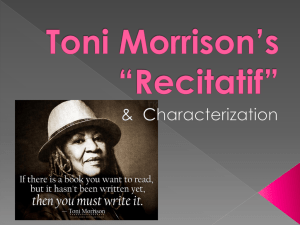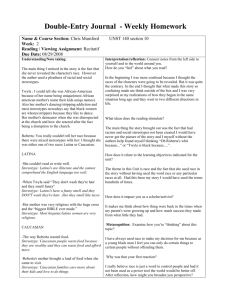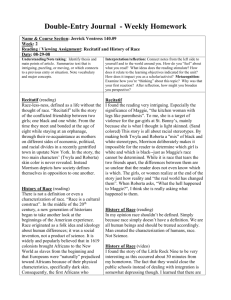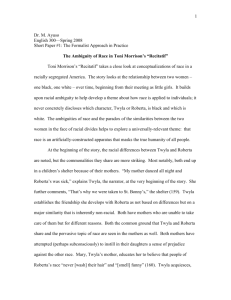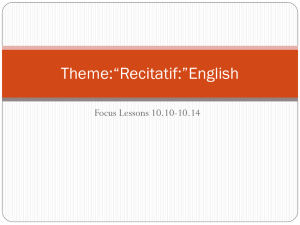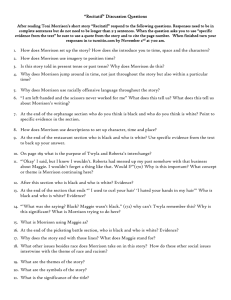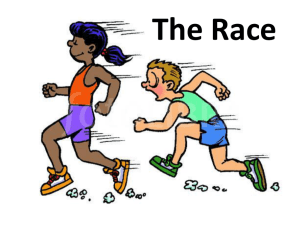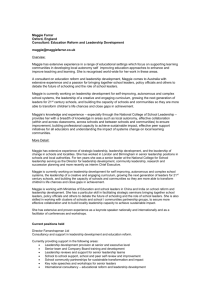36-2.2.stanley - WordPress.com
advertisement
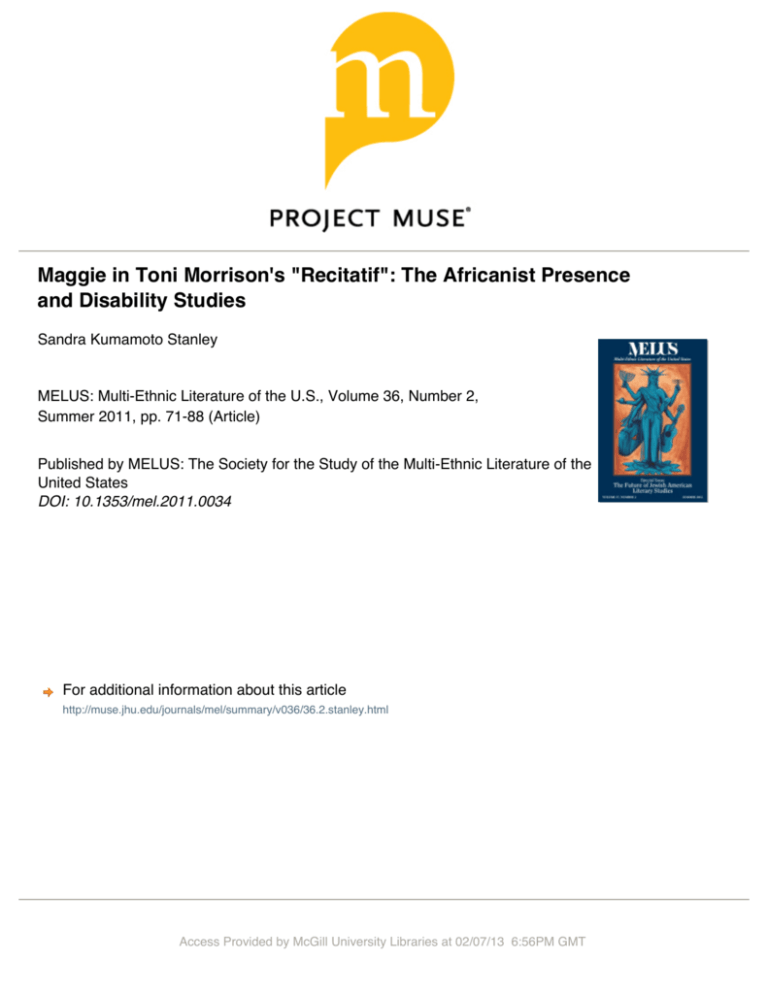
Maggie in Toni Morrison's "Recitatif": The Africanist Presence and Disability Studies Sandra Kumamoto Stanley MELUS: Multi-Ethnic Literature of the U.S., Volume 36, Number 2, Summer 2011, pp. 71-88 (Article) Published by MELUS: The Society for the Study of the Multi-Ethnic Literature of the United States DOI: 10.1353/mel.2011.0034 For additional information about this article http://muse.jhu.edu/journals/mel/summary/v036/36.2.stanley.html Access Provided by McGill University Libraries at 02/07/13 6:56PM GMT Maggie in Toni Morrison’s “Recitatif”: The Africanist Presence and Disability Studies Sandra Kumamoto Stanley California State University, Northridge Critics have regarded Toni Morrison’s “Recitatif” (1983) as a tour de force of racial readings and misreadings—a work exposing society’s unspoken racialized codes.1 In this short story tracing the lives of Twyla and Roberta from their youth in a shelter at St. Bonaventure to various stages of their adulthood, Morrison explores the experiences of two girls of different races, but she never reveals the race of either girl except through a series of social codes that underscore how race may be conflated with class, ambiguous physical traits, and social rituals such as eating certain foods. In Playing in the Dark: Whiteness and the Literary Imagination (1992), Morrison explains, “The only short story I have ever written, ‘Recitatif,’ was an experiment in the removal of all racial codes from a narrative about two characters of different races for whom racial identity is crucial” (xi). Thus, it is not surprising that critics have been preoccupied with the question: Which character is white and which character is black? Despite—or perhaps because of—Morrison’s provocative premise, “Recitatif” has excited little critical discussion beyond metadiscursive investigations of the racial and, to some extent, class markers associated with the two central characters.2 Yet there is a third character inhabiting the fictional recesses of Morrison’s work, haunting Twyla’s and Roberta’s memories: the mute and possibly deaf Maggie.3 Twyla and Roberta struggle years later to remember a scene in which Maggie, the childlike, elderly kitchen help, is brutalized by the shelter’s older “gar girls,”4 and the two main characters argue about whether or not they participated in the beating. Moreover, as they acknowledge that they never knew for certain whether Maggie was deaf as well as mute or whether she was black or white, they realize that their own ambivalent memories of her have been repressed and muted. Critics focusing on Twyla and Roberta either cursorily analyze Maggie’s role or interpret it in metaphoric relation to the two main characters. In such readings, Maggie is most commonly associated _________________________________________________________________________________ MELUS, Volume 36, Number 2 (Summer 2011) 72 STANLEY with representations of silence and absence, or, as Twyla and Roberta observe, with their failed mothers.5 Interpreted as a negative aesthetic representation rather than a transformable subject, Maggie becomes twice muted—first in the text and then by the critics. Indeed, while Twyla and Roberta are allowed to change throughout “Recitatif,” Maggie is trapped in a disabling cultural discourse. Homi Bhabha argues that at the heart of stereotyping is the “concept of ‘fixity’ in the ideological construction of otherness” (37). He notes that “fixity, as the sign of cultural/historical/racial difference,” is a “paradoxical mode of representation: it connotes rigidity and an unchanging order as well as disorder, degeneracy and daemonic repetition” (37). Thus, in contrast to Twyla and Roberta, Maggie, whose primary marker of difference is her disability, is the one character for whom the novel’s “ideological construction of otherness” remains fixed. Yet Morrison ends her story with Roberta’s anguished cry, “What the hell happened to Maggie?” (2698), clearly foregrounding Maggie’s role in the story. Roberta’s final cry is central to Morrison’s story. Rather than interrogating how critics read Twyla and Roberta, we may ask: How do Twyla and Roberta read Maggie? In shifting our focus from the cultural signs encasing Twyla and Roberta to those entrapping Maggie, Morrison asks readers to investigate how they read the stigmatized differences embedded in multiple narratives of identity, including race and disability.6 In situating “Recitatif” within the context of disability theory, I read Maggie as a figure who is entrapped within social boundaries reinforced by what Lennard J. Davis calls the “hegemony of normalcy” (12), yet she also disrupts these specific boundaries. Morrison’s narrative invites an exploration of the intersecting identity markers associated with disability and race, as well as a critique of the social processes and practices that shape these constructs. With its emphasis on discursive readings of differences and its challenge to cultural definitions of “inferiority,” disability studies shares much with multicultural studies.7 Both draw from current theories emphasizing the multiple constructions of otherness and the exploration of often unarticulated, potentially oppressive social codes. Disability theorist Tobin Siebers argues that disability can be classified as a “minority identity that must be addressed not as personal misfortune or individual defect but as the product of a disabling social and built environment” (Disability Theory 3), while Davis asserts that disability may be the “identity that links other identities” (233)—a “commonality of bodies within the notion of difference,” struggling against disabling “injustice and oppression” (241). Even as numerous critics associated with minority studies critique a society that enforces compulsory heterosexual,8 racial, and AFRICANIST PRESENCE AND DISABILITY 73 gender values upon groups, disability theorists such as Fiona Kumari Campbell and Robert McRuer critique the ideological underpinning of the “epistemologies and ontologies of ableism” (Campbell 1) and a “compulsory able-bodiedness” (McRuer 2) embedded in an ableist society. Scholars note that disability studies also bears an uneasy relationship to other minority studies. David T. Mitchell and Sharon L. Snyder observe: “As feminist, race, and sexuality studies sought to unmoor their identities from debilitating physical and cognitive associations, they inevitably positioned disability as the ‘real’ limitation from which they must escape” (2). For example, some argue that race, ethnicity, and gender as cultural representations differ from disability as identity categories, for unlike gendered and racial identities that many align with specific observable traits, disability is marked by a departure from a physical and functional norm. Hence, for many in mainstream society, the disabled body—the blind, the deaf, the mute, the amputee—is marked by an incompleteness. Women and people of color have long struggled against a dominant culture that places them in subordinate positions, defined by being outside of white, masculinist norms; gender and race studies, in their attempts to challenge physical and cognitive stereotypes and the material confines associated with these stereotypes, often identify charges that women and people of color are disabled as a sign of disempowerment, a sign that they must transcend. Thus, such a defensive statement as “We are as capable if not more capable than any member in this society” actually reinforces the ableist ideology that any departure from the cognitive and physical norms of that society is a sign of stigma.9 The intersection of race and disability may also be embodied in empowering ways. In Extraordinary Bodies: Figuring Physical Disability in American Culture and Literature (1997), the first major critical study to examine representations of disability in American literature and culture, Rosemarie Garland Thomson includes a section analyzing several of Morrison’s powerfully dis/abled heroines and highlighting how such characters as Eva Peace, Sula’s amputee grandmother, challenge socially prescribed categories. Thomson, who ignores the objectified character Maggie, acknowledges that in her reading of black women’s liberatory novels, she emphasizes the positive ways writers such as Morrison celebrate multiple differences, hence, in this instance, eliding the discourses of race and disability. One could argue that all marginalized groups may be subjected to negative stereotypes, what Morrison terms “discredited differences” (Playing 10), but the cultural ways that groups are “discredited” differ from one another—a point that Thomson makes earlier in her work. As Mitchell and Snyder note, although other groups fight racist, sexist, 74 STANLEY and heterosexist charges of undesirability and deviancy, many people with disabilities have to fight the social perception of disability as “the master trope of human disqualification” (3). In examining the social constructs of race and disability, I do not wish to homogenize these categories, but rather to explore how they richly inflect our understanding of how human identity is represented and produced. To some extent, I ask a larger question: What happens when representations of cultural otherness compete with each other? Analyzing literary figurations of blackness, Morrison critiques the construction of whiteness, asking the reader to examine not just the work of art (“the dream”) but also the artist (“the dreamer”); she argues that “the subject of the dream is the dreamer” (Playing 17). In doing so, she explores how white writers have created and used black bodies—such as Mark Twain’s Jim (in Huckleberry Finn) and Ernest Hemingway’s Wesley (in To Have and Have Not)—as functional literary tools, operating as overdetermined signifiers of the “bound, fixed, unfree, and serviceable” (73). In “Recitatif,” however, Morrison’s white and black figurations are underdetermined, precisely because her racial categories are ambiguous and shifting. Thus, the “serviceability of the Africanist presence” that Morrison analyzes in Playing in the Dark is provocatively transposed to the serviceability of the disabled presence in the figure of Maggie, who is read by the characters and critics alike as a signifier for the “bound, fixed, unfree, and serviceable” (73). In challenging oppressive master narratives of race, can Morrison at the same time be reinscribing other forms of stigmatized representation, highlighting the possibility of social transformation for some groups while ignoring others? Or does she foreground both, asking us to analyze not just the object of the dream, but also the dreamer—and, by extension, the socially interpellated values of that dreamer? In having the “sandy-colored” (2686) Maggie occupy the serviceable positions of the Africanist and disabled presence, Morrison tries to recover her from the recesses of cultural memory, thus exposing the flawed ideological basis of that cultural memory. For all the above reasons, “Recitatif” invites competing readings of identity markers, especially identity markers associated with “discredited differences.” One may argue that Morrison uses Maggie not only as a serviceable Africanist presence but also as a “master trope of human disqualification” that forces us to interrogate the ideology that would disqualify her. As such, Maggie acts as a disruptive presence to Twyla and Roberta, both of whom, despite suffering early on from maternal abandonment, eventually replicate the conventional bourgeois family for themselves. Even as the two women journey toward “normalcy,” the anomalous Maggie stubbornly refuses to disappear. Over a period of three decades, when the AFRICANIST PRESENCE AND DISABILITY 75 two women intermittently meet, their encounters are shadowed by their memory of Maggie, a memory that Twyla has repressed. In fact, Morrison first highlights Twyla’s memory of Maggie through a dreamscape, foregrounding Twyla’s role as a dreamer who is mystified by her dream: I used to dream a lot and almost always the orchard was there. . . . I don’t know why I dreamt about that orchard so much. Nothing really happened there. Nothing all that important, I mean. Just the big girls dancing and playing the radio. Roberta and me watching. Maggie fell down there once. The kitchen woman with legs like parentheses. And the big girls laughed at her. We should have helped her up, I know, but we were scared of those girls with lipstick and eyebrow pencil. Maggie couldn’t talk. The kids said she had her tongue cut out, but I think she was just born that way: mute. (2686) In his analysis of dreams, Sigmund Freud emphasizes the role of condensation—in which an image can act as a repository of collected meanings— and displacement—in which one potential image or sign can, through the act of substitution, correspond to the actual dream content—as tools to understand the semiotics of dreams. Through condensation and displacement, the orchard becomes for Twyla a repository of meanings that haunt her, a site of original trauma. For the girls, the orchard represents a space outside of the sterile shelter and the official regulations of Big Bozo, their name for Mrs. Itkin, the director of the shelter. Yet against nature’s trees, the two girls witness other regulatory social forms, especially the ritual of social exclusion enacted against Maggie. From Twyla’s perspective, the big girls, with their phallus-shaped lipstick and eyebrow pencil, dominate the orchard, and Maggie seems trapped by the limits of her corporeal body—by her bowed legs and muteness. Moreover, Maggie functions as a “serviceable” body: She was old and sandy-colored and she worked in the kitchen. I don’t know if she was nice or not. I just remember her legs like parentheses and how she rocked when she walked. She worked from early in the morning till two o’clock and if she was late, if she had too much cleaning and didn’t get out till two-fifteen or so, she’d cut through the orchard so she wouldn’t miss her bus and have to wait another hour. (2686-87) As a cleaning woman in the shelter, Maggie is a low-wage worker confined by socioeconomic boundaries. The big girls view Maggie—in terms of her physical and economic limitations—as someone they can harass with impunity. All the girls regard Maggie, despite the fact that she is an adult, as a helpless child. Noting that Maggie, with her “kid’s hat with ear flaps,” dresses like a child, Twyla pronounces that “even for a mute, it was dumb” (2687). 76 STANLEY Very soon after recalling this incident, Twyla remembers, “I think it was on the day before Maggie fell down that we found out our mothers were coming to visit us on the same Sunday” (2687). Clearly, Twyla associates her traumatic memory of Maggie falling down with her mother’s visit, which she recalls as another site of humiliation. Twyla depicts her own mother as a “fallen woman,” one who abandons her daughter “to go dancing,” a signifier suggesting her sexual activities. After assessing her mother’s tight green slacks, Twyla thinks with resignation, “A pretty mother on earth is better than a beautiful dead one in the sky even if she did leave you all alone to go dancing” (2688). However, after her mother embarrasses her with inappropriate social behavior, Twyla expresses her repressed anger: “Why did I think that she would come there and act right? . . . All I could think of was that she really needed to be killed” (2688). Twyla feels that both Mary (her mother) and Maggie, whom Twyla associates with the mother “deaf” and “dumb” to her needs (2697), deserve to be punished. Her memory of Maggie’s fall envelopes her memory of her mother; both are sites of shame and suffering that Twyla associates with a shelter—St. Bonny or the orchard—that paradoxically could not protect her. Thus, Maggie with her disabilities comes to represent Twyla’s own disabling moments; Twyla both identifies with Maggie and yet wishes to exclude and even erase her. Seeking to distinguish themselves from Maggie, Twyla and Roberta also are complicit in positioning Maggie as an outsider, a stigmatized outcast. At one point, Twyla and Roberta, wondering if Maggie is deaf as well as mute, call out to her, saying “Dummy” and “Bow legs” (2687). Twyla notes that Maggie does not react, “for she just rocked on, the chin straps of her baby boy hat swaying from side to side” (2687). This incident troubles Twyla, who instinctively recognizes the power of language to legitimate value for one group and to impose the role of social and corporeal inferiority on another; she wonders if Maggie did in fact hear their words. James C. Wilson and Cynthia Lewiecki-Wilson argue that the “‘natural view’ of disability is tied to the dominant view of language and the body”: “Language functions performatively as an address interpellating the body, not discovering but calling this naturalized meaning of disability into circulation, where it accords with and reinforces a host of other dualities” (2). Judith Butler notes that although injurious language needs a subject to utter the words, the subject is not the originator of that language, but has been discursively constituted within the social matrix. Using Louis Althusser’s terminology, Butler observes that the very act of naming—the address or call—is one of the conditions in which the subject is socially formed. By calling Maggie “Dummy” or “Bow legs,” Twyla and Roberta AFRICANIST PRESENCE AND DISABILITY 77 recirculate words they have heard or through which they have been discursively shaped. Butler notes that even though the subject may not respond, “[i]f we accept the notion that the linguistic constitution of the subject can take place without the subject’s knowing, as when one is constituted out of earshot, as, say, the referent of a third-person discourse, then interpellation can function without the ‘turning around,’ without anyone ever saying, ‘Here I am’” (33). In the case of Twyla and Roberta, I expand Butler’s reading of interpellation: although the two girls are the speaking subjects, they are also being formed in their act of naming Maggie; in fact, in their own way, they are the ones to respond, “Here I am” to their own address. Despite the fact that Maggie does not turn around, Twyla concludes, “I think she could hear and didn’t let on. And it shames me even now to think there was somebody in there after all who heard us call her those names and couldn’t tell on us” (2687). Citing Eve Kosofsky Sedgwick’s ideas on the “ethical leverage” of shame, Siebers notes that shame may promote “an identity in which difference may metamorphose into shared dignity with and ethical sympathy for victimized people”; however, Siebers also notes that it is important to interrogate the shame felt by “victimized people” and the reasons compelling them to feel that shame in an ableist society (Disability Theory 157). In the succeeding decades, the girls meet four times, and in these fairly brief encounters, each recalls the shame and trauma of her past, embodied in the memory of Maggie. Although J. Brooks Bouson does not analyze “Recitatif,” she does emphasize how Morrison bears witness to both personal and collective shame and trauma in the African American community. Citing Bessel van der Kolk and Onno van der Hart, Bouson notes that “when actual experiences are so overwhelming that they ‘cannot be integrated into existing mental frameworks,’ they are ‘dissociated, later to return intrusively as fragmented sensory or motoric experiences’” (7). Indeed, in the successive years, Maggie and their life at St. Bonny’s haunt the two girls, returning in fragmented pieces. In fact, when the two eightyear-old girls have their last encounter at the shelter, before Roberta’s departure, they meet in the orchard, and Twyla depicts it not as a site of recent trauma, but as an idyllic space, permeated with the smell of apple blossoms. The orchard, like her mother, promises a potential womblike safety, but in the end is a space she identifies with pain and confusion. During each successive encounter, Twyla begins to recover memories of that traumatic space, finding that something haunting did happen in the orchard. But her memories intrude only in fragmented forms, slowly seeping into her consciousness through symptomatic traces and gaps as the two women re-present elements of the past. Maggie may occupy a “fixed” 78 STANLEY space, but she has the power to disrupt Twyla’s and Roberta’s readings of their past and present, helping to transform their views of what Siebers calls the “other other” (Disability Theory 48). In their first meeting after St. Bonny’s, the girls do not specifically mention Maggie, but Twyla positions herself in Maggie’s place as a serviceable outsider. Twyla is working as a waitress at Howard Johnson’s, and she notices a skimpily clad Roberta enter with two young men. Situated in a “serviceable” relation to Roberta, Twyla is very conscious of her own headgear and her legs, two physical aspects that had marked Maggie: “Without looking I could see the blue and white triangle on my head, my hair shapeless in a net, my ankles thick in white oxfords” (2690). Viewing Roberta as a “gar girl,” she notes that Roberta’s own flamboyant makeup could rival the trademark makeup of these older girls: “Talk about lipstick and eyebrow pencil. She made the big girls look like nuns” (2689). She tentatively approaches Roberta, wondering if Roberta “wanted to be reminded of St. Bonny’s or to have anybody know she was ever there” (2689-90). Indicating her silence about the past, she admits, “I know I never talked about it to anybody” (2690). Their brief conversation leaves Twyla feeling alienated and excluded. On hearing that Twyla lives in Newburgh, Roberta treats her with dismissive rudeness: “She laughed then a private laugh that included the guys but only the guys, and they laughed with her. What could I do but laugh too. . . . There was this silence that came down right after I laughed. A silence it was her turn to fill up” (2690). As Butler notes, “One can be interpellated, put in place, given a place, through silence, through not being addressed, and this becomes painfully clear when we find ourselves preferring the occasion of being derogated to the one of not being addressed at all” (27). When Roberta snubs Twyla, positioning her in Maggie’s place as the devalued other, Twyla knows how to reverse her feelings of exclusion and powerlessness; she simply asks Roberta about her mother, whom we later find out had been not only sick, but also institutionalized (2698). Seeing Roberta’s “cracked” (2690) expression, Twyla transforms Roberta’s silence of exclusion into a shared desire for silence about their past. Unlike Maggie, who did not turn around, Twyla is able to turn and reverse the moment of injurious interpellation by reminding Roberta of their shared vulnerability. When they meet twelve years later in a trendy grocery store, both women have transformed their social positions—advancing beyond their prior limitations and their mothers’ socioeconomic status. Both women are now embedded in bourgeois society, identifying themselves through their husband’s names as wives and mothers. Twyla has become Mrs. James Benson and Roberta has become Mrs. Kenneth Norton, both adopting patronymic names in their search for legitimate social identities. Although AFRICANIST PRESENCE AND DISABILITY 79 Roberta, with her two servants and a Chinese chauffeur, is more affluent than Twyla, both women, who as girls struggled with learning basic reading skills, have become adept readers of society’s script. Anchored in the security of their respective bourgeois and upper middle-class identities, the two women now attempt to recover their past as a point of shared memory. They sit in a coffee shop, where a waitress serves them. Roberta is no longer a “gar girl” prototype, doomed to an orphaned and transient existence, and Twyla is no longer positioned as an economically serviceable body. At this point, both women can comfortably recall the past and laugh at what seems to be a distant life. A fragmented memory, however, now intrudes into their present, resurrecting former trauma. Twyla recalls, “Remember Maggie! The day she fell down and those gar girls laughed at her!” Surprised, Roberta corrects Twyla, asserting, “Maggie didn’t fall. . . . They knocked her down. Those girls pushed her down and tore her clothes. In the orchard” (2693). In seconds, Twyla’s memory of the orchard is transformed from a scene where “nothing really happened” (2686) into a scene of brutality and exposure. Clearly upset, Twyla denies Roberta’s version of the past, and Roberta tells Twyla, “You’ve blocked it, Twyla. It happened” (2693). Desiring not to confront the significance of “It happened,” Twyla quickly counters this memory with her own memory of Roberta snubbing her at Howard Johnson’s, positioning herself, rather than Maggie, in an ostracized position. Roberta justifies this past interaction through a binary social and racial reading: “Oh, Twyla, you know how it was in those days: black—white” (2693). But since neither of the women is textually marked and their racial identities are ambiguous, we cannot call upon our stereotypical social readings of race to interpret Roberta’s justification. However, we may ask, why is Twyla so upset and what is she “blocking”? In a curious way, both the orchard and Howard Johnson’s have become sites for potential agency and victimization. Morrison uses these settings as a means of enacting what Antonio Gramsci describes as a hegemonic order, the complex interaction of enforcement and consent in which the dominant group creates willing subjects, gaining the consent of its constituents through ideological enculturation. At the same time, Gramsci notes that while the dominant ideology works toward creating social cohesion, a counter-ideology of those who are exploited can work toward resistance. This complex performance of coercion, consent, and resistance forms the matrix of the characters’ interpellated identities. Here the personal is the political, for each of the hegemonic performances is enacted through Twyla and Roberta’s intersubjective relationship. At the end of this meeting, Twyla feels that Roberta “had messed up my past somehow with that business about Maggie” (2694), for Twyla must face the possibility that 80 STANLEY she was complicit with the dominant group—not as a victim, but as a perpetrator. In Morrison’s story, each meeting between Twyla and Roberta becomes a restaging of the repressed ideological and psychological interactions that occurred in the orchard. Shortly after this meeting, the two women find themselves on opposite sides of the social debate concerning school busing. Ironically, the issue of busing, which attempts to address the problem of social segregation, momentarily deflects Twyla’s attention from how she and Roberta were complicit in socially segregating Maggie. Although this busing conflict is situated in a public arena and motivated by political action, the two women’s behaviors are also animated by the past. Roberta opposes busing her children from her posh neighborhood. Twyla, however, has no clear opinion on the issue until she sees Roberta protesting busing, and she then positions herself against Roberta. Earlier, Twyla had stated, “I thought it was a good thing until I heard it was a bad thing. I mean I didn’t know” (2694). Given her ambivalence, Twyla’s strong reaction against Roberta’s stance appears puzzling. However, if one reassesses this scene not as Twyla’s desire to appear as a socially aware mother, but as her desire to reconstitute a past communal site in which she and Roberta shared an alternative space unmarked by either “racial strife . . . bearing down on you” (2694) or the vision of a brutalized Maggie, Twyla’s motivation becomes clearer. Although Twyla argues with Roberta, she also tries to separate her from the other protesting mothers by insisting that they represent a dominant and dominating hegemonic group: “Look at them Roberta. They’re Bozos.” When the women surround Twyla’s car, she reaches for Roberta’s hand “like the old days in the orchard,” desiring to reclaim their past relationship: “If one of us fell the other pulled her up and if one of us was caught the other stayed to kick and scratch, and neither would leave the other behind” (2695). However, Twyla fails to replicate a unifying past, which has now become “messed up.” This time, Roberta refuses to extend a protective hand; instead, she uses the past as a vehicle for division rather than union. Roberta further strips Twyla of her memories of the orchard, angrily declaring, “Maybe I am different now, Twyla. But you’re not. You’re the same little state kid who kicked a poor old black lady when she was down on the ground. You kicked a black lady and you have the nerve to call me a bigot” (2695). In a narrative in which racial markers have been suppressed, Morrison now positions Maggie as not only a disabled figure, but also an Africanist figure victimized by already disempowered children. Although Roberta’s statement ostensibly illuminates the past, her accusation also introduces enigmatic gaps. Since at no point in the text does Twyla accuse AFRICANIST PRESENCE AND DISABILITY 81 Roberta of bigotry, Roberta seems to be responding to an implied or imagined allegation. Moreover, Twyla denies that Maggie was black and accuses Roberta of lying. Assessing who is the more reliable witness may be difficult. On the one hand, Roberta, who ostensibly does not struggle with repressed memories to the extent that Twyla does, has been the one to provide Twyla with revealing information about the past. On the other hand, as the storyteller, Twyla controls the narrative arc, bearing witness to the selective past that seeps into the present. In any case, Morrison suggests that the past is already a culturally and psychologically mediated construct, revealing not a transcendent historical truth but a series of representations of that history. The two women invoke these readings of the past as a means of justifying their present interactions. Although Twyla participates in a counterprotest against the anti-busing mothers, she admits that her sign does not make sense without Roberta’s sign, for she states, “my sign was for her.” When she constructs a sign that queries, “Is your mother well?” Twyla, as she did in Howard Johnson’s, silences Roberta, who disappears from the picket lines (2696). Twyla’s intersubjective and intertextual relation with Roberta propels Twyla to advocate a political position, but the other mothers in Twyla’s picket line are simply confused by her social script, which primarily can be understood as an individual rather than a collective message. Within the context of these battling mothers, Twyla and Roberta are not free from the memories of their own dancing, sick mothers, whom society determined to be unfit and marked by disabling signs. In the end, the protest results in classes being suspended, and the children spend their free time watching The Price Is Right and The Brady Bunch, television shows that perpetuate an American market society that both fetishizes commodities and commodifies white able-bodied American families as an ideal—an ideal that does not include a figure like Maggie or, in fact, their own mothers. Engaged in their own culture wars, the women, caught up in the busing debate, ignore how their children are already being enculturated through the media, replicating the “hegemony of normalcy” (Davis 12). In a key moment at the end of the story, Twyla struggles to remember Maggie and what happened in the orchard. Giving her own assessment of Roberta’s interpretation of the past, Twyla continues to be puzzled by Maggie’s racial identity, but she is confident that she did not kick Maggie. In her epiphany, Twyla realizes how she had projected her own feelings of inadequacy and her mother’s identity upon Maggie. Although Twyla appears to be routinely placed in various subordinate positions, she functions in a powerful discursive role; as the narrator-storyteller, she acts as 82 STANLEY the prime receptacle of personal and cultural memory and meaning. In fact, near the end of the story, she provides the reader with her own interpretation of her actions and of Maggie’s significance: I didn’t kick her; I didn’t join in with the gar girls and kick that lady, but I sure did want to. We watched and never tried to help her and never called for help. Maggie was my dancing mother. Deaf, I thought, and dumb. Nobody inside. Nobody who would hear you if you cried in the night. Nobody who could tell you anything important that you could use. Rocking, dancing, swaying as she walked. And when the gar girls pushed her down, and started roughhousing, I knew she wouldn’t scream, couldn’t—just like me—and I was glad about that. (2697) Twyla reads Maggie as a metaphor of her own experience, representing an absence rather than a presence: Twyla projects her own feelings of powerlessness stemming from her unresponsive mother, who was deaf and dumb to her cries, upon Maggie. Echoing Twyla’s own interpretive framework, the critics Elizabeth Abel and David Goldstein-Shirley also emphasize how Maggie represents absence. In fact both critics point to Morrison’s description of Maggie’s legs resembling parentheses. Goldstein-Shirley states, “Parentheses indicate something of secondary importance, which, added to Maggie’s muteness, connote a passive, marginalized victim, a cipher; the bow legs conjure the image of zero itself. Reduced to nothing, Maggie is robbed of agency, which leaves for her only the role of pawn in the battle of memories waged by Twyla and Roberta over three decades” (n. pag.). During those three decades, Maggie becomes a repository for both Twyla’s and Roberta’s anxieties about their mothers and their identities. Sarah Madsen Hardy argues that Maggie helps Roberta and Twyla access their unresolved feelings toward their mothers and that the two women will never know what happened to Maggie, “nor will they ever be as whole as if they had not abandoned Maggie, and eventually, each other.” The above readings reaffirm Twyla’s reading. In a curious way, she has taken the traumatic memory of Maggie’s victimization and transformed it into a site for her own feelings of victimization, substituting herself for Maggie. She even substitutes her mother for Maggie, and ironically, in such a reversal, Maggie becomes the one who victimizes Twyla. But if we look through the lens of an Africanist and disability reading, we may wish to examine the parentheses—Maggie’s bowed legs—not as a sign for emptiness, but, to borrow Mitchell and Snyder’s term, as a narrative prosthetic,10 a rhetorical device critiquing a world that would reduce Maggie to this cipher. Morrison reminds us that Maggie not only needs to be remem- AFRICANIST PRESENCE AND DISABILITY 83 bered for the sake of Twyla’s and Roberta’s relationship, but also needs to be recovered, in a larger social sense, from a cultural amnesia and a repressed history that would metonymically reduce her body to her bow legs that “conjure the image of zero itself.” Rather than focusing on the “zero,” one might see how the legs themselves, as Petra Kuppers argues about the “scar of visibility,” can become a site of productive engagement, inciting the narrative and representing the embodied experience (1). Instead of erasing Maggie, Morrison flaunts her, foregrounding her material existence in the context of the story’s most significant and traumatic moment: Maggie’s beating by the girls in the orchard. In their final meeting, Roberta confirms Twyla’s reading of the past. She first admits her own confusion concerning Maggie’s racial identity: “I really did think she was black. I didn’t make that up. I really thought so. But now I can’t be sure. I just remember her as old, so old. And because she couldn’t talk—well, you know, I thought she was crazy. She’d been brought up in an institution like my mother was and like I thought I would be too” (2698). Here Roberta conflates Maggie’s silence with her own fear of cognitive and affective disabilities. Moreover, Roberta continues to put Maggie in the Africanist position. In her analysis of the Africanist signifier in Playing in the Dark, Morrison notes the propensity for white authors to use a variety of linguistic strategies in describing the Africanist presence, including metonymic displacement, metaphysical condensation, and dehistoricizing allegory.11 These strategies all work to trap characters into fixed types without acknowledging how identity is individually situated in a specific time and place. For instance, in metonymic displacement, “physical traits become metonyms that displace rather than signify the Africanist character,” while in metaphysical condensation and dehistoricizing allegory, “social and historical differences” are transformed into “universal differences,” foreclosing rather than disclosing an understanding of “hierarchic difference” (Morrison, Playing 68-69). Both women have read and continue to read Maggie through metonymic displacement, metaphysical condensation, and dehistoricizing allegory, perceiving her as represented by her physical and cognitive disabilities, signifying “the ultimate trope of human disqualification” (Mitchell and Snyder 3). Yet, as the women attempt to deal with their memory of Maggie, they both begin to reread her role, recognizing how they identified with her and realizing how they failed her—enacting the “ethical leverage” of shame (Siebers, Disability Theory 157). Despite their differences in race and class, both Twyla and Roberta agree in their readings of Maggie as a “shadow figure” that embodied their projected and conflicted visions of themselves and their mothers.12 In their willingness to recover Maggie from their past 84 STANLEY and to interrogate their memories of her, the two women also acknowledge how they were responsible for her beating. Earlier Twyla had confessed: “We watched and never tried to help her and never called for help.” Both characters contribute to Maggie’s exploitation and diminished status, positioning her as a “shadow figure.” Although Roberta explains that the gar girls were the ones to beat Maggie, she admits, “It was just that I wanted to do it so bad that day—wanting to is doing it” (2698). Roberta equates her psychological desire with social action, apprehending how the individual is the site of the collective. In retrieving Maggie from their past and their cultural amnesia, the two women have begun the process of understanding how they have been “romancing the shadow” (Morrison, Playing in the Dark 29) and using the disabled subject as an arena for their own enablement. We may all very well echo Roberta’s final anguished cry, “What the hell happened to Maggie?” (2698). Although initially providing Twyla and Roberta with a vehicle for their own epiphanies, Maggie stubbornly remains an elusive, haunting figure at the conclusion of the story. In the end, this final cry may indicate two contrasting visions of Maggie. On the one hand, as the two women journey toward fulfilling dominant cultural expectations—a journey toward social “normalcy”—Maggie continues to represent the corporeal and affective departures from those expectations, remaining “bound and unfree” (Morrison, Playing 73) within the narrative. On the other hand, these final words might suggest something quite different: while Roberta and Twyla’s narrative draws to a close, Maggie’s narrative is still open. As the character who incites and disrupts the narrative, Maggie has enacted her own agency, flaunting her own narrative prosthetic by her very embodied presence that cannot be reduced to parentheses. As Siebers argues, “Disability enlarges our vision of human variation and difference, and puts forward perspectives that test presuppositions” (Disability Aesthetics 3). In foregrounding Maggie’s role and raising the question about how she is read in a society that would “mute” her existence, Morrison interrogates the role of the dreamer as well as the dream. As Morrison has so powerfully shown in Playing in the Dark, we need “to analyze the [artist/dreamer’s] manipulation” of those who are “bound and/ or rejected” (53) and reveal how such a narrative represents and regulates not only such psychological projections as guilt, despair, and fear, but also racialized and ableist ideologies. Noting that the metaphor of race remains a potent, yet often repressed and unexamined ordeal within the national consciousness, Morrison warns, “All of us, readers and writers, are bereft when criticism remains too polite or too fearful to notice a disrupting AFRICANIST PRESENCE AND DISABILITY 85 darkness before its eyes” (91). Roberta’s anguished cry suggests that we need to recover varied forms of repressed otherness—disability as well as race—from the recesses of cultural memory, exploring how multiple literary representations disrupt and erupt into the politics of our reading. Notes 1. For example, see Elizabeth Abel, Ann Rayson, and Naomi Morgenstern. 2. Abel asserts that Toni Morrison’s story demonstrates that the way a reader interprets racial markers is influenced by the reader’s race and experience, and David Goldstein-Shirley presents an analysis of Morrison’s ambiguous narrative through interpretations of multiple ideological, linguistic, physical, and historical clues. Focusing on the two main characters, Rayson argues for a class-based reading of “Recitatif,” while Kathryn Nicol explores both the ambiguity of race and its ideological implications. In her reading of James Baldwin’s “Sonny’s Blues” and Morrison’s “Recitatif,” Trudier Harris argues, “How characters are positioned in these texts mirrors how readers are positioned in reading them” (104). 3. I am consciously collapsing a number of possible descriptors—mute, deaf, bowlegged—linked to Maggie. I understand that placing these multiple descriptors under the category of disability is problematic. For instance, as Harlan Lane notes, many in the deaf culture would see themselves not as people with disabilities, but as a linguistic minority (84). 4. Roberta, mishearing the term gargoyles in a civics class, nicknames the older girls the “gar girls” (2692). 5. In early readings of “Recitatif,” critics such as Abel foreground the metaphoric significance of Maggie’s bow legs, signifying a parenthetical absence, as well as Twyla’s and Roberta’s view of Maggie in relationship to their failed mothers (Abel 472). Helane Adams Androne also highlights the symbolic connection between Maggie and Twyla’s and Roberta’s mothers, noting the two women’s need to face their memories of the “absent/present paradigm of mothering” and to transcend the traumatic memory of Maggie, who represents the “archetype of their fears” (142). 6. I recognize that disability is a contested term, for to many in the nondisabled majority it suggests functional impairment rather than the limitations of societal attitudes; the term, however, has a recognized history associated with both academic studies and political rights movements. 7. An interdisciplinary field, disability studies regards disability as a social construct and people with disabilities as a minority group. Based on the work of disability rights activists and such key legislation as the 1990 Americans with Disabilities Act, its proponents advocate for the rights of people with disabilities. 8. See Adrienne Rich. 86 STANLEY 9. David T. Mitchell and Sharon L. Snyder also note that critics in minority and disability studies have critiqued the phenomenon of passing as the individual’s desire to distance the self from “stigmatizing associations” (3), but while the person of color may rely upon skin color or other phenotypic traits as a means to disguise difference, the person with a disability might use prosthetic devices to better mask difference. 10. Mitchell and Snyder challenge such mainstream conceptions of disability by foregrounding the prosthetic as a rhetorical device. Although mainstream society views the prosthetic as a means by which the disabled body may be restored to “some semblance of originary wholeness,” they argue that this perception is based on the false recognition that the disabled body is aberrant and apart from social norms and expectations. In their use of a narrative prosthetic, however, they expose mainstream representations and beliefs; instead of using the prosthetic narrative to erase difference, they use it “to flaunt the prosthetic’s imperfect supplementation as an illusion” in order to expose the artificiality of not only the prosthetic but also cultural definitions of normativity (8). 11. Morrison develops her linguistic strategies from the categories that James A. Snead outlines. 12. In Playing in the Dark, Morrison discusses the role of the shadow in her chapter “Romancing the Shadow” (29-60). Works Cited Abel, Elizabeth. “Black Writing, White Reading: Race and the Politics of Feminist Interpretation.” Critical Inquiry 19.3 (1993): 470-98. Androne, Helane Adams. “Revised Memories and Colliding Identities: Absence and Presence in Morrison’s ‘Recitatif’ and Viramontes’s ‘Tears on My Pillow.’” MELUS 32.2 (2007): 133-50. Bhabha, Homi. “The Other Question.” Screen 24.6 (1983): 18-36. Rpt. in Contemporary Postcolonial Theory: A Reader. Ed. Padmini Mongia. London: Arnold, 1996. 37-54. Bouson, J. Brooks. Quiet As It’s Kept: Shame, Trauma, and Race in the Novels of Toni Morrison. Albany: State U of New York P, 2000. Butler, Judith. Excitable Speech: A Politics of the Performative. New York: Routledge, 1997. Campbell, Fiona Kumari. The Contours of Ableism: The Production of Disability and Abledness. Basingstoke: Palgrave, 2009. Davis, Lennard J. “Constructing Normalcy: The Bell Curve, the Novel, and the Invention of the Disabled Body in the Nineteenth Century.” Davis, Disability 3-16. AFRICANIST PRESENCE AND DISABILITY 87 —, ed. The Disability Studies Reader. 2nd ed. New York: Routledge, 2006. —. “The End of Identity Politics and the Beginning of Dismodernism: On Disability as an Unstable Category.” Davis, Disability 231-42. Freud, Sigmund. The Interpretation of Dreams. 1899. Trans. James Strachey. New York: Avon, 1965. Goldstein-Shirley, David. “Race and Response: Toni Morrison’s ‘Recitatif.’” Short Story 5.1 (1997): 77-86. Literature Resource Center. Web. 9 Apr. 2011. N. pag. Gramsci, Antonio. Selections from the Prison Notebooks of Antonio Gramsci. Ed. and trans. Quintin Hoare and Geoffrey Nowell-Smith. New York: International, 1971. Hardy, Sarah Madsen. “Recitatif.” Short Stories for Students. Detroit: Gale, 2002. N. pag. Literature Resource Center. Web. 11 Sept. 2010. Harris, Trudier. “Watchers Watching Watchers: Positioning Characters and Readers in Baldwin’s ‘Sonny’s Blues’ and Morrison’s ‘Recitatif.’” James Baldwin and Toni Morrison: Comparative Critical and Theoretical Essays. Ed. Lovalerie King and Lynn Orilla Scott. New York: Palgrave, 2006. 10320. Kuppers, Petra. The Scar of Visibility: Medical Performances and Contemporary Art. Minneapolis: U of Minnesota P, 2007. Lane, Harlan. “Construction of Deafness.” Davis, Disability 79-92. McRuer, Robert. Crip Theory: Cultural Signs of Queerness and Disability. New York: New York UP, 2006. Mitchell, David T., and Sharon L. Snyder. Narrative Prosthesis: Disability and the Dependencies of Discourse. Ann Arbor: U of Michigan P, 2000. Morgenstern, Naomi. “Literature Reads Theory: Remarks on Teaching with Toni Morrison.” University of Toronto Quarterly 74.3 (2005): 816-28. Morrison, Toni. Playing in the Dark: Whiteness and the Literary Imagination. 1992. New York: Vintage-Random, 1993. —. “Recitatif.” The Norton Anthology of American Literature. Ed. Nina Baym et al. 7th ed. Vol. E. New York: Norton, 2007. 2685-98. Nicol, Kathryn. “Visible Differences: Viewing Racial Identity in Toni Morrison’s Paradise and ‘Recitatif.’” Literature and Racial Ambiguity. Ed. Teresa Hubel and Neil Brooks. Amsterdam: Rodopi, 2002. 209-31. Rayson, Ann. “Decoding for Race: Toni Morrison’s ‘Recitatif’ and Being White, Teaching Black.” Changing Representations of Minorities East and West. Ed. Larry E. Smith and John Rieder. Honolulu: U of Hawai’i P, 1996. 41-46. Rich, Adrienne. “Compulsory Heterosexuality and Lesbian Existence.” Blood, Bread, and Poetry: Selected Prose 1979-1985. New York: Norton, 1994. 2375. Siebers, Tobin. Disability Aesthetics. Ann Arbor: U of Michigan P, 2010. —. Disability Theory. Ann Arbor: U of Michigan P, 2008. 88 STANLEY Snead, James A. Figures of Division: William Faulkner’s Major Novels. New York: Methuen, 1986. x-xi. Thomson, Rosemarie Garland. Extraordinary Bodies: Figuring Physical Disability in American Culture and Literature. New York: Columbia UP, 1997. Wilson, James C., and Cynthia Lewiecki-Wilson. “Disability, Rhetoric, and the Body.” Embodied Rhetorics: Disability in Language and Culture. Ed. Wilson and Lewiecki-Wilson. Carbondale: Southern Illinois UP, 2001. 1-24.
